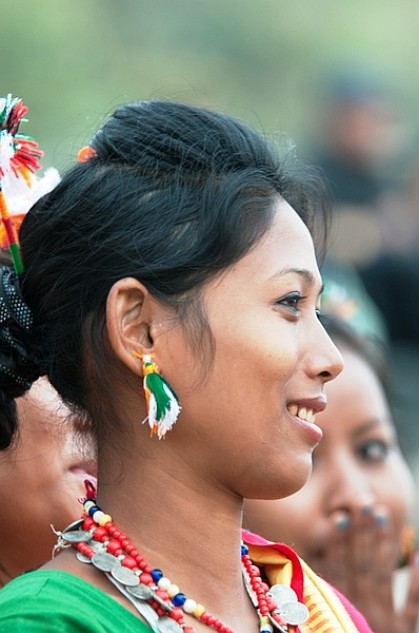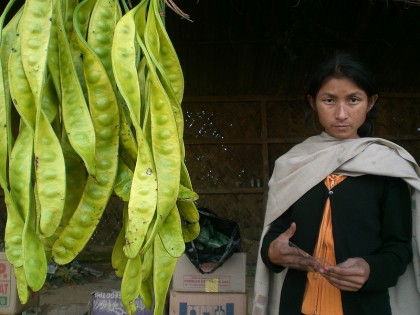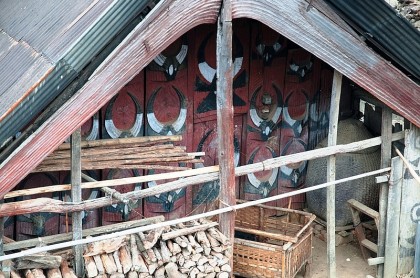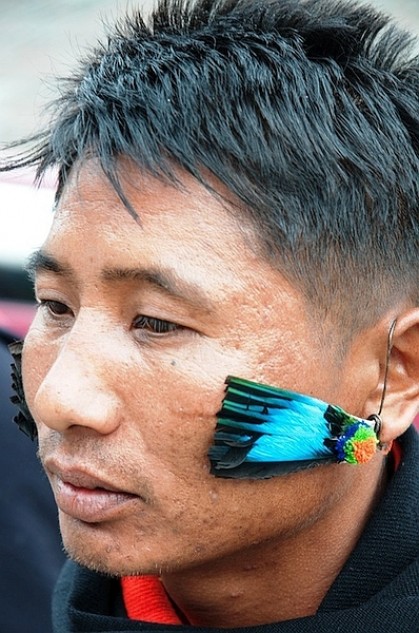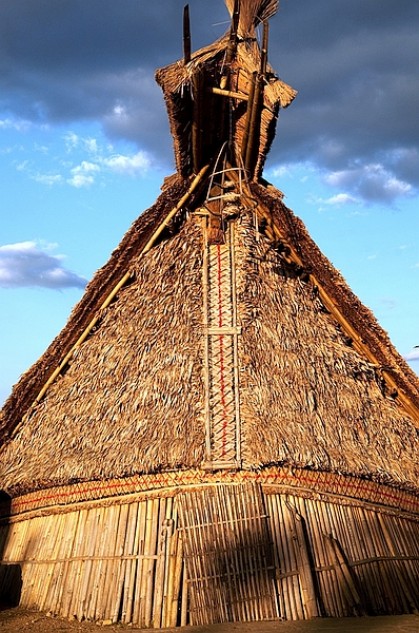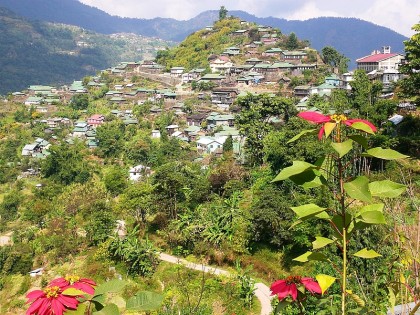
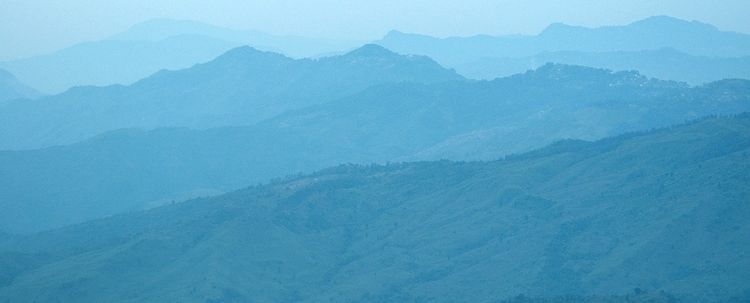
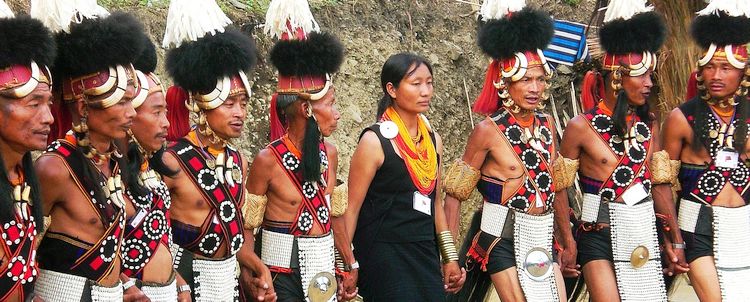
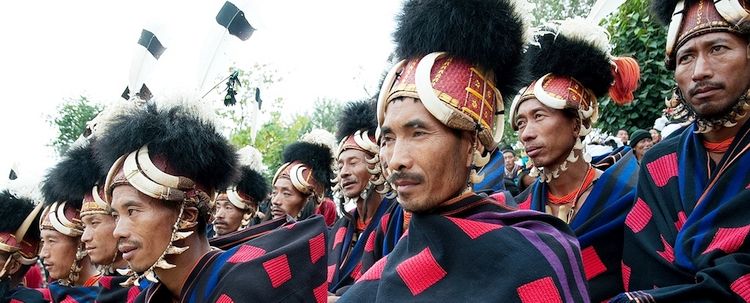
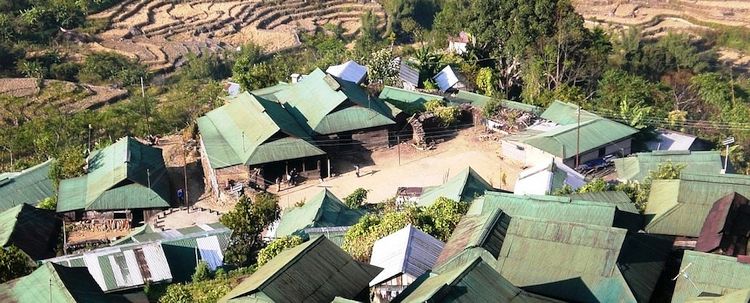
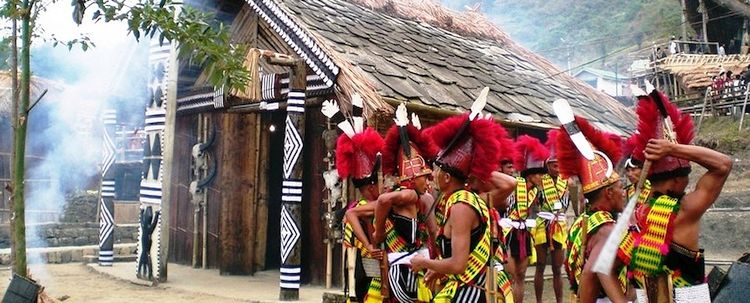
Pages Under this section
The Hidden World of the Naga
Best Travel Period | Nagaland in Brief | Peoples and Religions | Food | Flora and Fauna | National Parks and Nature Reserves | History | Economy | Mountain Scenery and Trekking | Festival Calendar
Nagaland is a rather small Indian state with an area of only 16,527 square kilometers, and less than 2 million inhabitants. Situated in a remote region in the mountains of northeastern India it is one of the seven sister states and is bordered by the Indian states of Manipur, Assam and Arunachal Pradesh, as well as Myanmar (also Burma or Burma) in the southeast. Almost 90% of the total population belongs to one of the 16 Naga indigenous peoples, accordingly wide is the linguistic and cultural diversity in this area. Although the history of the former head-hunters is largely unknown because of the absence of a written, historical documentation, but the remarkably warm and hospitable people invite visitors gladly to take part in their traditional festivals, and so to enjoy a direct encounter with their lived culture. Exotic singing and beating of the drums draw the guests of such a festival equally into their spell as the participating tribesmen themselves. Anyone who is interested in the culture of northeast Indian natives, will come into contact with the multifaceted diversity of tribal cultures during a holiday in Nagaland.
The remoteness of the region preserves, besides the culture, also the rich, original variety of flora and fauna. Agricultural use is limited to what is necessary for the own consumption of the people living here, apart from a few exceptions. Any further industrialization is virtually nonexistent. Since Nagaland lies in the foothills of the Himalayas, subtropical flora with dense rhododendron forests full of orchids predominates, whose variety of birds will not only make the hearts of passionate ornithologist soar higher. The many voices of singing birds already hint at their biodiversity; of course also some rare, partly nearly extinct species breed here. The geographical proximity to the Kaziranga National Park invites you to marvel at the variety of hunters and herbivores, and be on the lookout on a safari for Bengal tigers, rhinoceros and Asian elephant. The biodiversity of the Nagaland region is amazing, and discloses a variety of plants with medical benefits, which the Western physicians are now only beginning to understand.
With pleasure we include the visit of a ritual celebration in Nagaland into your India roundtrip (advisable in a combination with a tour of Assam or Meghalaya) or enable you an intense immersion into the culture of the Naga peoples during a prolonged stay. Maybe your bridge to the Indian culture leads onto the festival site of a village in Nagaland?
Best Travel Period
With the sultry monsoon (June to September) the country radiates in lush greenery. From October to March the climate is suitable for cultural and hiking vacations. Cultural vacations are especiallinteresting during the harvesting season from October to November. Celebrations will be held in the various districts throughout the year. The Naga Hornbill Festival in early December offers a fantastic opportunity to get an impression from all the 16 tribes of Nagaland.
Nagaland in Brief
| Location | In the remote mountains of northeastern India, between Myanmar (Burma) to the east and three other northeast Indian states: Arunachal Pradesh in the north-east, Assam in the north and west, Manipur in the south. |
| Area | 16.527 km² |
| Population | 1.980.602/ 119 per km² (2011) |
| Capital | Kohima |
| Districts | 11: Dimapur, Kiphire, Kohima, Longleng, Mokokchung, Mon, Peren, Phek, Tuensang, Wokha, Zunheboto |
| Topography | Mountainous almost everywhere with the Saramati Peak (3841 m above sea level) as the highest mountain on the border with Burma. Other mountains are the Glory Peak (2233 m above sea level), the Veda Peak and the Japfu peak (3048 m above sea level). The average altitude of the country is 900 to 1200 m above sea level. The terrain is crossed by many rivers, including the rivers Dhansiri, Doyang, Dikhu, Milak, Tizu, Zunki and Melak. |
| Vegetation | Evergreen rain forest to subalpine highland forests which are rich in bamboo, pines, orchids and rhododendrons. The subtropical rainforests in the lower areas are rich in biodiversity and medicinal plants. The forest covers about 33% of the country. |
| Wildlife | The variety of vegetation is the habitat of many rare plants and animals such as tigers, leopards, bears, rhinoceroses, wild elephants, Gayal-cattle, Mithun-buffalo Bos frontalis, gibbons and birds, including the rare hornbills Tragopan blythii. |
| Climate | Subtropical to temperate depending on the altitude. The year can be divided into three seasons: summer (hot and humid) from March to May, Monsoon (sultry and very humid) from June to September, as well as winter (cool to cold and dry) from December to February. In February and March, strong northwest winds cross the country, in April and May short, heavy rainfall has to be expected. Pleasant climate in spring and autumn. |
| Temperatures | Summer: from 16 ° C to 31 ° C, Winter: from -5 ° C to 24 ° C, the lowest temperatures in December and January. |
| Precipitation | 1,750 to 2500 mm per year, 80% of the rain falls during the monsoon. |
| Languages | Nagamese as the common language, numerous languages and dialects of the different tribes with Tibeto-Burmese roots; Assamese, Hindi and English (official) |
| Ethnicties | 16 tribes: Angami, Rengma, Zeliang, Kuki, Kachari, Chakhesang, Lochurn, Chang, Ao, Konyak, Lhom, Khiamniungam, Vimchunger, Sangtam, Lotha, Sumi |
| Religions | 90% Christians (Baptists), almost 8% Hindus and almost 2% Muslims; but the original animism / shamanism, combined with ancestor worship, is still quite widespread among the people. |
| Economy | Agriculture |
| Getting there | Flight to Kolkata or Delhi. From Delhi connecting flight to Guwahati and Dimapur or from Kolkata direct flight to Dimapur, Nagaland's only airport, not far from the border with Assam. Continuation of the trip from Dimapur or Guwahati Airport by jeep. |
| Visa / Entry permit | For the entry to India, a passport which is valid at least six more months and a visa are required. In addition, an entry permit for Nagaland. This RAP - Restricted Area Permit - for Nagaland we organize ahead of the trip for you. |
| Vaccinations | Vaccinations against hepatitis A, polio, tetanus, combined with diphtheria are highly recommended, if the last vaccination dates back more than 10 years. Detailed vaccination recommendations, you will receive from us upon registration. |
Peoples and Religions
The collective term "Naga" includes about 30 different ethnic groups of Tibeto-Burmese origin in the mountains of the far north-east of India and the north-west of Myanmar, the former Burma. The humorous and deeply religious people have a rich culture of handicrafts, unique folklore, dances and music. Poetic love songs, gospel and modern songs go hand in hand. In their appearance, their language and their customs in some cases considerably different, share the Naga groups basic beliefs, cultural traditions and social practices. Due to their otherworldly and inaccessible environment, as well as many a political turmoil - 65 years their territory was closed to foreigners - the Naga have retained many ancient traditions, although missionaries have converted almost the entire population away from animistic beliefs to Christianity.
But even though most of the Nagas profess Christianity, the animistic primal human culture continues to be present here. The Nagas see themselves as images of nature. Their musical forms of expression are intended to praise "the universe, the flora and fauna and all that exists on earth". One believes in the value of the striving for harmony, and the fact that humans, animals and all that exists are equal. People also believe in life after death, which is why ancestor worship and animism occupy an important place. A rather small proportion of today's population in Nagaland is of Hindu faith (around 7.8%), moreover live here still less than 2% Muslims.
The original peoples can be roughly divided into a northern, a central and a southern group, wherein the transitions are flowing. The main groups are the Konyak, the Khiamniungan and the Yimchunger, as well as the Ao, Sema and Angami. The tribes differ in language, settlement area, traditions and governmental structure. The Angami, Lotha, Rengma and Ao are democratically organized. The Angami select their chieftain based on his wealth, his appearance and his diplomatic skills. Nevertheless, decisions are taken in consultation with all the villagers. For the Sema, however, the chieftain is determined by the bloodline.
The chieftain is concerned about the welfare of the villagers, distributes land, helps financially, provides protection and arranges marriages. The villagers worship the chieftain as a father, for whom they work and fight. For the Sema it was a tradition that the eldest son established a separate village outside the territory of the father, which resulted in a regionally relatively wide dispersion of these people. Among the Aos, the village is governed by a council of elders. Each village is democratic and independent. The Konyak chiefs are considered sacred and they are called "Ahngs", which means as much as "the beginning of everything". They are both autocrats and democrats, wearing richly decorated dresses and are highly respected and revered by the villagers. The Konyaks believe that they are direct descendants from Moses.
Biblical names like Mosa, Kaisa, Aron are widespread among the people. The Konyaks are known for their tattooed faces, their blackened teeth and their headhunter past. Quite different are also the wedding traditions of the tribes. Common to them is that all Nagas prohibit marriage within the same clan. The only exceptions here are the Konyak chiefs, they are considered so sacred that their main wife must come from the same clan.
Among the traditional occupations of women of all tribes belong the gathering of wood, the fetching of water, cooking, rice beer brewing, working in the field and weaving. Among the Angamis it is for a young woman by the way normal to have a lover, the Sema on the other hand watch with great care over their young women, so that a generous dowry can be demanded. Among the Aos prevails a relatively liberal attitude, among the Konyaks sexual intercourse before marriage is usual.
Over the centuries, the proud and martial Nagas have developed unique cultural traits with their headhunter past. They find expression in their legends, their martial arts, their exotic headpieces, their tattooed faces ( the Konyaks) and in their rich musical, dance and poetry culture.
More than 80% of the population of Nagaland live in small, isolated villages, are self sufficient through agriculture and are hunter-gatherers.
Food
The staple food in Nagaland is rice. It is eaten with meat, vegetables and very hot chili. Numerous wild vegetable, herb and fruit varieties are used in the Naga cuisine. Often their diversity is dependent on chance, as only relatively little area is cultivated and selectively used. Further, extremely unusual for the European palate are ingredients like insects, caterpillars and spiders, as well as dog or cat meat. Meat is often dried to make it durable. In some areas, a special bread from "sticky rice" is being prepared on an open fire, a successful and tasty form of preservation. As a drink, rice beer is prevalent everywhere, next to fresh spring water, and very popular, although Nagaland is officially considered a "dry" state. This rice beer is traditionally served in a rustic bamboo cup.
Flora and Fauna
Since they were once almost completely forested - from evergreen rainforest to sub-alpine high forest - were the inaccessible Naga areas at altitudes over 2500 meters refuges for the tribes of the natives and for rare plants and animals, such as tigers, leopards, bears, Indian rhinoceros, elephants, gayal cattle, mithun buffalo, gibbons and hornbills. Several forest areas are sacred to the tribes and still virtually untouched. Since the few agriculturally used areas are mainly built in harmony with nature, an extraordinary biodiversity has been retained to this day. In the protected areas in particular you have the chance of the sighting of bears, or even gray giants like rhinoceroses and elephants. Monkeys inhabit the crowns of the forests, and overpower, when something startles them, even briefly the diverse birdsong.
National Parks and Nature Reserves
Khonoma Nature Conservation Tragopan Sanctuary
Not far from Kohima, this nature reserve with its 25 square kilometers area of protected surface habitat for numerous species of birds (Tragopan) and many interesting and rare plant species.
Fakim Wildlife Sanctuary
This small nature reserve in the eastern mountains near Myanmar offers a rich subtropical plant diversity, created thanks to heavy rainfall in June and July.
Rangapahar Reserve Forest
In this 20-hectare area, the most diverse species of birds can be observed (myna, cuckoo, parrot, sunbird, parakeet, robi, quail, woodpeckers, hornbill, swift hawk, crows). Even monkeys, tigers, deer, porcupines and squirrels are native here.
Ghosu Bird Sanctuary
In the district of Zunheboto in the land of the Sumi Nagas, the village population maintains a bird reserve with populations of more than 20 endangered bird species.
History
Little is known about the early history of Nagaland, and there are no written records. Legends tell of migration of populations, heroes, legendary lovers or describe the origin of mankind. Of several of these circumstances remind to this day stone monuments and stone formations in many parts of Nagaland. The Angami Nagas, for example possess an extensive megalith tradition. The raised stones are reminiscents of big events such as natural phenomena, or they honor heroic families. All Nagas were brave, freedom-loving warriors and hunters; feuds between Naga villages and tribes were widespread. Therefore, the villages were built only where they could also be defended well.
The settlements were protected by stone walls, bamboo spears, wooden gates and moats. In the villages of Kohima and Khonoma such protective structures have been preserved and give an idea of the underlying techniques. Before the 13th century, the region was ruled by the mighty Kachari tribe, Dimapur was their capital. Today ruins and monoliths remind in and around Dimapur City about this high culture of the Kacharis. In early times, the Nagas were headhunters, for a variety of reasons. With the head trophies of warring tribes the warriors decorated their houses, making their status visible for all villagers. In addition, it was hoped on, for example a better harvest as a result for a sacrifice. In August 1978 seems to have been the last head hunting in the district of Tuensang.
The British established in 1832 the first contacts with the peoples of Nagaland, but encountered very much resistance. The last organized uprising against British colonization took place from 1879 to 1880 in Khonoma, then in 1881 British India first took over officially the government affairs. In the time of the Second World War, a bloody battle between the Allied and Japan was held in the capital of Nagaland. With India's independence in 1949, the regions of Nagaland, Meghalaya and Assam were merged to the State of "Assam". The demand of the Nagas for a separate political status was getting louder in the early 1960s; In 1963 finally the status of an independent state of the Indian Republic has been granted to them. In 1964 then, the first democratic elections were held in Nagaland.
Naga separatists nevertheless continued with their violent opposition to achieve a fully autonomous status for Nagaland, and the incorporation of all areas populated by Nagas of the neighboring states of northeastern India. Since 1995, the country is reopened to foreign visitors in a limited way. Since August 1, 2000, promising peace negotiations are underway and in most regions harmony has taken place. Today Nagaland has a large degree of autonomy. Special regulations allow the Naga tribes to manage their affairs largely autonomously. Each tribe has consultants who take care of local disputes at the village and tribal level.
Economy
Approximately 70% of the population are engaged in agriculture. The majority operates agriculture solely for self sufficiency: rice, millet, corn and legumes are among the main products. In addition, sugar cane, potatoes, coffee, cardamom, tea, pineapple and rapeseed are cultivated. The rice cultivation for self sufficiency takes up the largest part by far with 80% of the agricultural land area. Among the bigger companies of Nagaland counts the sugar mill in Dimapur, with a capacity of 1000 tons per day. There are also numerous medium and small enterprises in the area of bamboo and rattan processing, handicrafts, paper and textile industries, as well as tourism.

